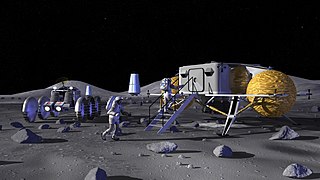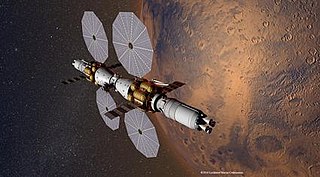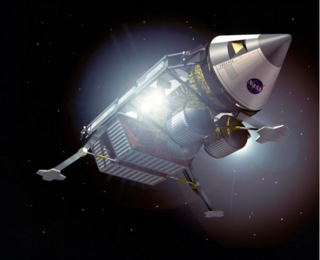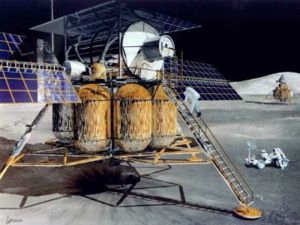
Space exploration is the use of astronomy and space technology to explore outer space. While the exploration of space is carried out mainly by astronomers with telescopes, its physical exploration is conducted both by uncrewed robotic space probes and human spaceflight. Space exploration, like its classical form astronomy, is one of the main sources for space science.

The Constellation program was a crewed spaceflight program developed by NASA, the space agency of the United States, from 2005 to 2009. The major goals of the program were "completion of the International Space Station" and a "return to the Moon no later than 2020" with a crewed flight to the planet Mars as the ultimate goal. The program's logo reflected the three stages of the program: the Earth (ISS), the Moon, and finally Mars—while the Mars goal also found expression in the name given to the program's booster rockets: Ares. The technological aims of the program included the regaining of significant astronaut experience beyond low Earth orbit and the development of technologies necessary to enable sustained human presence on other planetary bodies.

The Vision for Space Exploration (VSE) was a plan for space exploration announced on January 14, 2004 by President George W. Bush. It was conceived as a response to the Space Shuttle Columbia disaster, the state of human spaceflight at NASA, and as a way to regain public enthusiasm for space exploration.
The Apollo Applications Program (AAP) was created as early as 1966 by NASA headquarters to develop science-based human spaceflight missions using hardware developed for the Apollo program. AAP was the ultimate development of a number of official and unofficial Apollo follow-on projects studied at various NASA labs. However, the AAP's ambitious initial plans became an early casualty when the Johnson Administration declined to support it adequately, partly in order to implement its Great Society set of domestic programs while remaining within a $100 billion budget. Thus, Fiscal Year 1967 ultimately allocated $80 million to the AAP, compared to NASA's preliminary estimates of $450 million necessary to fund a full-scale AAP program for that year, with over $1 billion being required for FY 1968. The AAP eventually led to Skylab, which absorbed much of what had been developed under Apollo Applications.

The Space Transportation System (STS), also known internally to NASA as the Integrated Program Plan (IPP), was a proposed system of reusable crewed space vehicles envisioned in 1969 to support extended operations beyond the Apollo program.. The purpose of the system was two-fold: to reduce the cost of spaceflight by replacing the current method of launching capsules on expendable rockets with reusable spacecraft; and to support ambitious follow-on programs including permanent orbiting space stations around Earth and the Moon, and a human landing mission to Mars.

The Exploration Systems Architecture Study (ESAS) is the official title of a large-scale, system level study released by the National Aeronautics and Space Administration (NASA) in November 2005 of his goal of returning astronauts to the Moon and eventually Mars—known as the Vision for Space Exploration. The Constellation Program was cancelled in 2010 by the Obama Administration and replaced with the Space Launch System, later renamed as the Artemis Program in 2017 under the Trump Administration.

The Crew Exploration Vehicle (CEV) was a component of the U.S. NASA Vision for Space Exploration plan. A competition was held to design a spacecraft that could carry humans to the destinations envisioned by the plan. The winning design was the Orion spacecraft.

The following outline is provided as an overview of and topical guide to space exploration.

NASA has proposed several concept moonbases for achieving a permanent presence of humans on the Moon since the late 1950s. Research and exploration of the Moon has been a large focus of the organization since the Apollo program. NASA's peak budget was in 1964-1965, when it comprised 4% of all federal spending in service of the Apollo moon landing project. Though lunar landings ever since the conclusion of the Apollo program in 1972 have ceased, interest in establishing a permanent habitation on the lunar surface or beyond low earth orbit has remained steady. Recently, renewed interest in lunar landing has lead to increased funding and project planning. NASA requested an increase in the 2020 budget of $1.6 billion, in order to make another crewed mission to the Moon under the Artemis program by 2025, followed by a sustained presence on the Moon by 2028. A crew was selected for the planned manned mission, Artemis II, in April of 2023.

The Space Exploration Initiative was a 1989–1993 space public policy initiative of the George H. W. Bush administration.

The National Aeronautics and Space Administration is an independent agency of the U.S. federal government responsible for the civil space program, aeronautics research, and space research. Established in 1958, NASA succeeded the National Advisory Committee for Aeronautics (NACA) to give the U.S. space development effort a distinctly civilian orientation, emphasizing peaceful applications in space science. NASA has since led most American space exploration, including Project Mercury, Project Gemini, the 1968–1972 Apollo Moon landing missions, the Skylab space station, and the Space Shuttle. NASA currently supports the International Space Station and oversees the development of the Orion spacecraft and the Space Launch System for the crewed lunar Artemis program, the Commercial Crew spacecraft, and the planned Lunar Gateway space station.

The Review of United States Human Space Flight Plans Committee, better known as the HSF Committee, Augustine Commission, or Augustine Committee, was a group convened by NASA at the request of the Office of Science and Technology Policy (OSTP), to review the nation's human spaceflight plans to ensure "a vigorous and sustainable path to achieving its boldest aspirations in space." The review was announced by the OSTP on May 7, 2009. It covered human spaceflight options after the time NASA had planned to retire the Space Shuttle. A summary report was provided to the OSTP Director John Holdren, White House Office of Science and Technology Policy (OSTP), and NASA Administrator on September 8, 2009. The estimated cost associated with the review was expected to be US$3 million. The committee was scheduled to be active for 180 days; the report was released on October 22, 2009.

DIRECT was a late-2000s proposed alternative super heavy lift launch vehicle architecture supporting NASA's Vision for Space Exploration that would replace the space agency's planned Ares I and Ares V rockets with a family of Shuttle-Derived Launch Vehicles named "Jupiter". It was intended to be the alternative to the Ares I and Ares V rockets which were under development for the Constellation program, intended to develop the Orion spacecraft for use in Earth orbit, the Moon, and Mars.

The space policy of the Barack Obama administration was announced by U.S. President Barack Obama on April 15, 2010, at a major space policy speech at Kennedy Space Center. He committed to increasing NASA funding by $6 billion over five years and completing the design of a new heavy-lift launch vehicle by 2015 and to begin construction thereafter. He also predicted a U.S.-crewed orbital Mars mission by the mid-2030s, preceded by the Asteroid Redirect Mission by 2025. In response to concerns over job losses, Obama promised a $40 million effort to help Space Coast workers affected by the cancellation of the Space Shuttle program and Constellation program.

Mars Base Camp (MBC) is a crewed Mars laboratory orbiter concept under study that was commissioned by NASA from Lockheed Martin in US. It would use both future and proven concepts as well as the Orion MPCV, also built by Lockheed Martin.

The Artemis program is a robotic and human Moon exploration program led by the United States' National Aeronautics and Space Administration (NASA) along with five major partner agencies— the European Space Agency (ESA), the Japan Aerospace Exploration Agency (JAXA), the Canadian Space Agency (CSA), the Israel Space Agency (ISA) and the Australian Space Agency (ASA). The Artemis program is intended to reestablish a human presence on the Moon for the first time since the Apollo 17 mission in 1972. The main parts of the program are the Space Launch System (SLS), the Orion spacecraft, the Lunar Gateway space station, and the commercial Human Landing Systems. The program's long-term goal is to establish a permanent base on the Moon to facilitate the feasibility of human missions to Mars.

The International Lunar Resources Exploration Concept (ILREC) was a proposed mission architecture under President George H. W. Bush's Space Exploration Initiative (SEI) by Kent Joosten, an engineer at Johnson Space Center. The plan would have used the help of international partners, mainly the Soviet Union, to assemble a lunar base and sustainable lunar transportation service.

First Lunar Outpost was a proposal for a crewed lunar mission that would have launched sometime in the 2010s. It was part of George H. W. Bush's Space Exploration Initiative. The main purpose of the proposal was to offer a much cheaper alternative to NASA's 90-day study from 1989 by a factor of US$30 billion. Although it did not gather much mainstream attention, NASA dedicated much time to assembling a very detailed and thorough proposal. However, the entire Space Exploration Initiative was cancelled soon after the proposal's completion, and NASA had to close the Office of Space Exploration in March 1993.

















